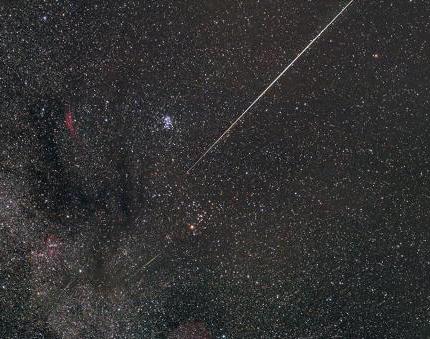2020 April 21
Imaging the Lyrid meteors with a DSLR

In its simplest form, capturing meteors with a DSLR entails taking time exposures with a tripod-mounted camera, lens (usually a wide-angle) at full aperture and a high ISO setting (1600 or 3200 ISO), in the hope that a bright meteor will flash through the field of view while the shutter is open. Although meteors may appear in any part of the sky, it is generally considered best to centre your camera’s field of view at about 50° elevation above the horizon and, say, 30° to 40° elongation from the shower radiant, which is R.A. 18h 07m, Decl.+33°, not far from the star Kappa Lyrae.
Digital SLR cameras are very efficient at collecting background light from the sky, particularly at a high ISO setting, so exposures should be kept relatively short – no more than one minute’s duration in a really dark, rural location, and probably only 10 to 15 seconds from a more typical observing site. With longer exposures and an unguided camera the stars produce trailed images: if a sufficiently bright meteor appeared in the camera’s field of view, it will recorded as a longer trail cutting across those of the background stars.
With equatorially-mounted cameras, guided at sidereal rate, or if exposures are kept short (say 15 seconds) with an unguided camera, any meteor trails are accurately recorded against the background stars. Another real benefit of keeping the exposures short (i.e. 15 seconds) is that satellite trails (of which there are a considerable number) will typically be recorded across a number of consecutive frames and may therefore be distinguished from meteor trails.
With many DSLRs, the camera can be operated using a programmable timer attached to the shutter control to take repeated exposures (continuous mode) one after the other for as long as required, provided the battery is fully-charged beforehand. If this is the case the camera(s) can be left operating while carrying out a visual meteor watch at the same time. Remember to record the numbers of both shower and sporadic (non-shower) meteors during the watch period which should ideally be an hour or more in duration. Indeed, it is recommended that the observer carry out a visual watch in parallel with camera exposures, noting details of all meteors seen. Satellites and any aircraft crossing the field can leave meteor-like trails, and should also be noted.
Wide-angle lenses of 18-28 mm focal length, with their correspondingly larger fields of view, may yield a higher meteor capture rate, but they do give a reduced image scale. If you want to capture as many meteor trails as possible use the lens at full aperture, i.e. the lowest f/no. that the lens will allow. For more accurate positional work, lenses of longer, 50-75 mm focal length are preferable for the increased image scale they produce.
Imaging meteors requires patience and perseverance, and one will generally take a large number of unsuccessful exposures for every meteor captured. even on nights of high meteor activity. As a general rule of thumb only meteors brighter than about magnitude zero are likely to register on the image. The fainter meteors, which make up the bulk of activity on any night, are unlikely to be recorded on camera, but they will be seen by the visual observer particularly in clear, dark skies.
Please make sure that the clock on the camera (and your own watch if observing visually) is accurately set to UT before the night’s work begins.
Happy meteor watching!
J.W. Mason
Director, BAA Meteor Section
2020 April 20
| The British Astronomical Association supports amateur astronomers around the UK and the rest of the world. Find out more about the BAA or join us. |
